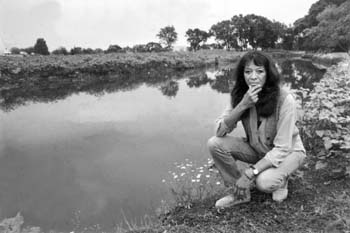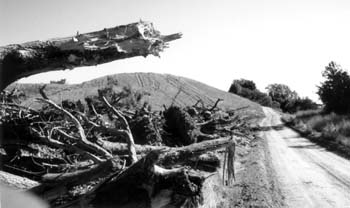![[MetroActive News&Issues]](/gifs/news468.gif)
[ Sonoma County | MetroActive Central | Archives ]
Slippery Slope
Voice in the wilderness: The county's new ordinance on hillside vineyard planting is a model of consensus, many conservationists say. West county activist Ann Maurice begs to differ, calling the long-awaited law " a scam."
Is the county's new ordinance on hillside vineyard planting a bust?
By Janet Wells
THAT'S NOT their job!" Ann Maurice's voice practically explodes into the phone before launching into a tirade about county officials who Maurice says are selling the deed to the proverbial ranch to the burgeoning wine-grape-growing industry. "The wine industry is just too close to this county. This is proof that the Board of Supervisors is selling us out to wine interests," she says.
What has Maurice in such a tizzy? The county's long-awaited vineyard-planting ordinance, to which the Board of Supervisors is slated to give final approval June 15. Vineyard neighbors and many other county residents had hoped the ordinance would stem the tide of forest conversion, help curtail increasing pesticide use, and stop the degradation of fish habitat.
But Maurice argues that the resulting law falls far short of those goals.
First Maurice takes umbrage against the ordinance's stated purpose to "protect the lands ... while ensuring the ongoing economic viability of the wine industry."
"I wish they had ensured the viability of the fishing industry. Then the marina out at Bodega Bay wouldn't be in the disaster it is in," she fumes. "If one of their purposes was to ensure the viability of salmon and steelhead, there wouldn't be a problem in the river. But they didn't give a damn, no.
"They're going to lead us to hell in a hand basket," she adds. "It's not in the personal interest of the people in the county to have methyl bromide all over their property. It's not in our interest to have a mono-crop."
Maurice, a Sebastopol artist who has done graduate work in land use and economic geography, criticizes the ordinance as putting the cart before the horse by penalizing growers for failing to comply with erosion-control standards that the county has not yet adopted.
"How could they pass an ordinance that says we'll throw you in jail if you don't comply with regulations that don't exist?" she says. "They're telling us, 'We'll come up with those.' This should be one whole package. How do we know if those erosion-control guidelines are going to be worth dog shit?"
Finally, there's the part that really galls Maurice: The ordinance has no appeal process.
"So if you're next door to the [new vineyard], you're clean out of luck if you don't like it," she says. "Even rapists and mass murderers have the right to appeal. Isn't that a fundamental right of due process guaranteed in the Constitution? Since when did any county bureaucrat get to be king?"
While west county activist Maurice is the leading--and loudest--voice against the law she calls a "scam" and a "sick game," more than 1,000 residents have agreed with her, signing a petition asking the supervisors to delay voting on the ordinance. And even a consultant hired by the county cautions that the ordinance may have significant flaws.
On the other side, many in the county are hailing the hillside-planting ordinance as a landmark in agricultural regulation and a positive step in relations between environmentalists and growers. "You never get everything you want when you sit down with the other side, who never gets what they want either," says Sonoma County Conservation Action board chairman Bill Kortum, regarded as the dean of the local conservation movement. "This was a classic case where we finally reached a compromise. There are aspects that could be improved upon, but we're way ahead of where we were."
Says Sonoma County Conservation Action director Mark Green, who spent the better part of two years negotiating the tenets of the ordinance with growers, "We made a great leap forward with this vineyard-planting ordinance. The status previously was unregulated, where landowners could do whatever they wanted."
THE BASIC PROVISIONS of the ordinance require growers to obtain and pay for permits to plant grapes and to provide erosion-control plans for steeper acreage. In addition, the ordinance requires that vineyards on the edge of waterways abide by a 25- to 50-foot setback, depending on the slope of the acreage.
The ordinance reflects the public's growing concern as the region's $300 million wine-grape industry expands into erosion-prone hills and fragile riparian zones. In the past few years several incidents spurred environmentalists to make noise about a ballot initiative to put limits on vineyard development. Gallo Winery was cited for recontouring hills and planting along the edge of Porter Creek, and a vineyard above Warm Springs Dam was fined $50,000 for steep-slope planting that led to an enormous amount of soil eroding into the Gualala River during a severe winter storm.
A proposal that surfaced recently to convert 10,000 acres of forestlands in Mendocino and Sonoma counties into vineyards--a project that would equal one sixth of all currently cultivated vineyard land in both counties--is the kind of mammoth scheme that motivates the public to call for stringent regulations.
Maurice, no surprise, is of the opinion that any environmentalist who backs the ordinance has sold out. She has harsh words for a law that does not address pesticides or habitat protection and mandates modest setbacks that she calls "outrageous." Federal agencies have recommended setbacks of 300 feet or more when threatened species like coho salmon and steelhead are in the area, Maurice hastens to point out.
"Better than what the county did is if they said that setbacks had to be adequate to protect aquatic life in creeks and waterways for maintenance of the ecosystem, rather than say 25 feet is fine," she says. "I'm concerned that plugging that number in at 25 undermines other regulatory agencies that have been arguing for more."
Green, whose voice gets weary at criticism of the end result of a delicate negotiating process, explains that growers and others with vested agricultural interests refused to include habitat protection as part of any discussion.
"There are state laws that do that," he says. "And the moment that the industry wasn't willing to have habitat on the table, they relinquished the right for us not to complain about habitat. The setbacks are for erosion control, not habitat.
"Considering that we have no setbacks now, at any angle the setbacks are a significant step and a significant concession from the growers," he adds.
Scarred landscape: Felled trees marked Gallo's west county hillside.
THE ORDINANCE itself is a work in progress, since June 15 marks the third time it has come before the supervisors. On April 13 and again on May 11, the supervisors indicated support for the ordinance, but sent the document back to staff for changes in language and policy.
One of Maurice's hot-button issues--the county's nonexistent erosion-control guidelines--is expected to be adopted by the supervisors before the ordinance goes into effect on Oct. 1 and will be based on standards recommended by the Resource Conservation District, says Supervisor Mike Reilly. "The question is whether we want to adopt those in whole or tinker with them. We want a little bit of time to fine-tune stuff for Sonoma County," he says.
Napa County's 8-year-old vineyard-planting ordinance, known as the Conservation Regulations and that served as a model for the new Sonoma County law, has worked "extremely well," reducing potential erosion from 14 tons per acre annually to 2.5 tons per acre, says Jeff Redding, Napa's director of Conservation, Development and Planning.
While both ordinances seek to reduce damage caused by soil runoff into local drinking water and habitat, the two have several critical differences. Sonoma County's law will be regulated by the county agricultural commissioner. Napa's Resource Conservation Department works with growers to develop an erosion-control plan and sends growers to the county planning department for a use permit only if the vineyard site is over a 30 percent slope.
Unlike Sonoma County, Napa requires projects with greater than 30 percent slope to undergo review based on the tougher California Environmental Quality Act.
"Our Agriculture Department is not a regulatory agency," Redding says. "[The slope planting is] really a land-use issue. Unless yours has skills ours doesn't, the ag commissioner is not trained in soil erosion."
Says Dave Steiner, a soil conservationist with the Napa Resource Conservation District, hired by Sonoma County as a consultant on its ordinance, "Sonoma County is trying to say it's not a land-use issue. Agriculture is a permitted land use, so it's not subject to CEQA review."
Steiner says the biggest red flag he sees in Sonoma County's ordinance is a loophole that allows growers to plant on hills with more than 50 percent slope if less than 7.5 percent of the planting area is over the 50 percent mark.
"People are going to spend a lot of time nitpicking and making determinations. It will take a lot of staff time," he says. "If a corporation came in with a 100-acre project with only 7.5 percent over the threshold, they would be able to satisfy the ordinance," he explains. "But if a small farmer came in with those same 7.5 acres as a stand-alone project, it wouldn't be exempted."
The penalty structure for the two ordinances also differ. Sonoma County can fine up to $1,000 a day or six months in jail. Napa has fined growers up to $10,000 for failing to comply with regulations, enforced through the Business and Professions Code, Redding says. "Our zoning ordinance has a $500 maximum or six months in jail. That's not enough," he says. "This is a business decision, often. If the cost of the fine is less than the benefit of not following the regulations, that's what [businesses] do."
SONOMA COUNTY, says Steiner, has "a lot of holes to fill in" before the ordinance will be ready to go into effect in October. But, he adds, "a public forum is not very helpful in working out the details.
"The problem with the current concord is that it was not worked out with much technical expertise. The negotiating team worked in good faith, long and hard, but they have an emotional stake in the compromises whether or not they are going to work," he says. "I don't see a problem with leaving the fine-tuning to the ag commissioner and the county counsel. It may not be popular," he adds.
"I don't know the extent to which the public and the growers trust the county."
That would be not much, if you ask firebrand Ann Maurice. "Trust the supervisors? Ha!" she scoffs. "What did somebody say, the price of democracy is eternal vigilance'?
"Double that for Sonoma County."
[ Sonoma County | MetroActive Central | Archives ]
Copyright © Metro Publishing Inc. Maintained by Boulevards New Media.
![]()

Photo by Michael Amsler
Photo by Michael Amsler
From the June 3-9, 1999 issue of the Sonoma County Independent.